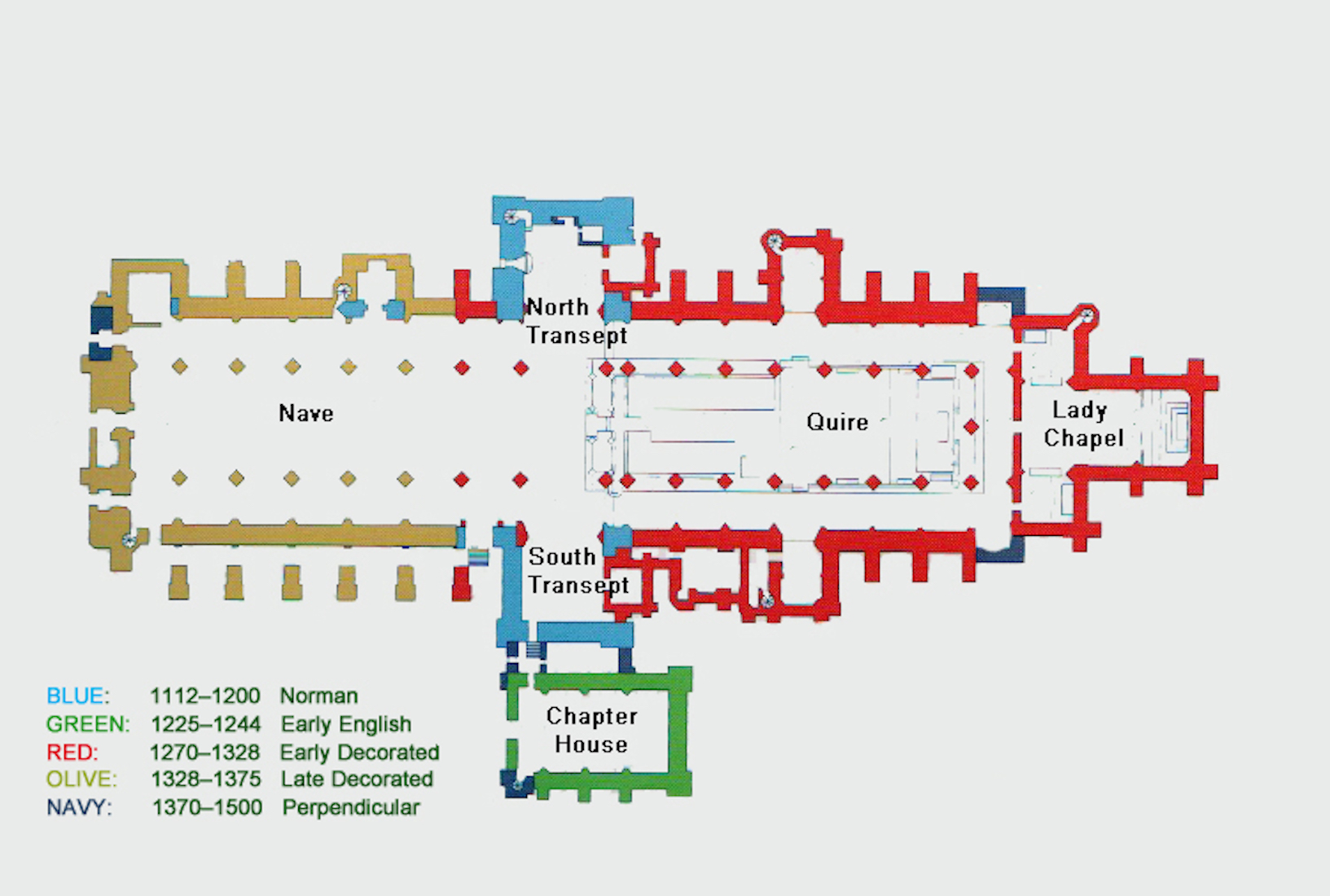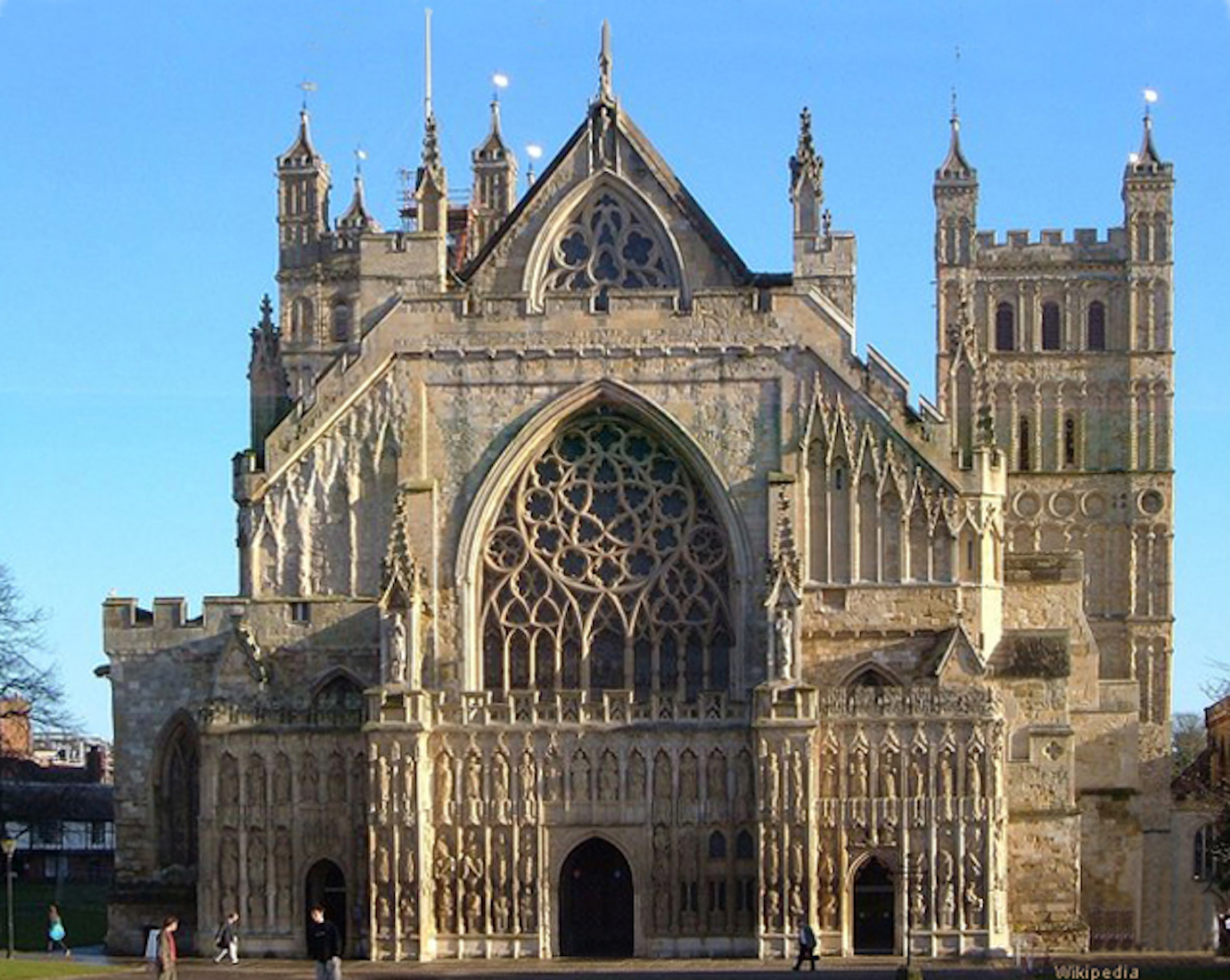EXETER CATHEDRAL
DEVON ENGLAND
PAUL SCOTT

The plan shows how the Cathedral was built and enlarged over some 400 years. The transepts are the oldest part, built in the traditional Norman style with windows with rounded tops. This was the original Cathedral built under the direction of William Warelwast, Bishop of Exeter, but already by the 1270s it was being demolished to make way for a new Cathedral which was bigger, grander, lighter and in the Gothic style. Financial records dating from the 1270s survive today, mostly intact, and represent one of the most complete set of fabric accounts for any cathedral in Europe.
[Plan from Cathedral booklet]
A brief history of the Cathedral is given below, but if you want to being your tour of the Cathedral immediately, tap / click on START .
You can access intermediate points in the tour by a tap / click on the following links:
To continue now, start with START!
NOTE ON MAGNIFYING IMAGES
With this website format the images are large enough for most purposes. If there is a need for greater magnification of an image, go to the identical photo on
https://www.flickr.com/photos/paulscottinfo/albums
and use Command - + (Mac) or Windows - + (Windows).
HISTORY
[Wikipedia]
The founding of the Cathedral at Exeter, dedicated to Saint Peter, dates from 1050, when the seat of the bishop of Devon and Cornwall was transferred from Crediton because of a fear of sea-raids. A Saxon minster already existing within the town (and dedicated to Saint Mary and Saint Peter) was used by Bishop Leofric as his seat, but services were often held out of doors, close to the site of the present Cathedral building.
In 1107 William Warelwast was appointed to the see, and this was the catalyst for the building of a new cathedral in the Norman style. Its official foundation was in 1133, during Warelwast’s time, but it took many more years to complete. Following the appointment of Walter Bronescombe as bishop in 1258, the building was already recognised as outmoded, and it was rebuilt in the Decorated Gothic style, following the example of Salisbury. However, much of the Norman building was kept, including the two massive square towers and part of the walls. It was constructed entirely of local stone, including Purbeck Marble. The new Cathedral was complete by about 1400, apart from the addition of the chapter house and chantry chapels.
Like most English cathedrals, Exeter suffered during the Dissolution of the Monasteries, but not as much as it would have done had it been a monastic foundation. Further damage was done during the Civil War, when the cloisters were destroyed. Following the restoration of Charles II, a new pipe organ was built in the Cathedral by John Loosemore. Charles II’s sister, Henrietta Anne of England, was baptised here in 1644. During the Victorian era, some refurbishment was carried out by George Gilbert Scott. As a boy, the composer Matthew Locke was trained in the choir of Exeter Cathedral, under Edward Gibbons, the brother of Orlando Gibbons. His name can be found scribed into the stone organ screen.
During the Second World War, Exeter was one of the targets of a German air offensive against British cities of cultural and historical importance, which became known as the ‘Baedeker Blitz’. On 4 May 1942 an early-morning air raid took place over Exeter. The cathedral sustained a direct hit by a large high-explosive bomb on the chapel of St James, completely demolishing it. The muniment room above, three bays of the aisle and two flying buttresses were also destroyed in the blast. The medieval wooden screen opposite the chapel was smashed into many pieces by the blast, but it has been reconstructed and restored. Many of the cathedral's most important artefacts, such as the ancient glass (including the great East window), the misericords, the bishop’s throne, the Exeter Book, the ancient charters (of King Athelstan and Edward the Confessor) and other precious documents from the library had been removed in anticipation of such an attack. The precious effigy of Walter Branscombe had been protected by sand bags. Subsequent repairs and the clearance of the area around the Western end of the building uncovered portions of earlier structures, including remains of the Roman city and of the original Norman Cathedral.



